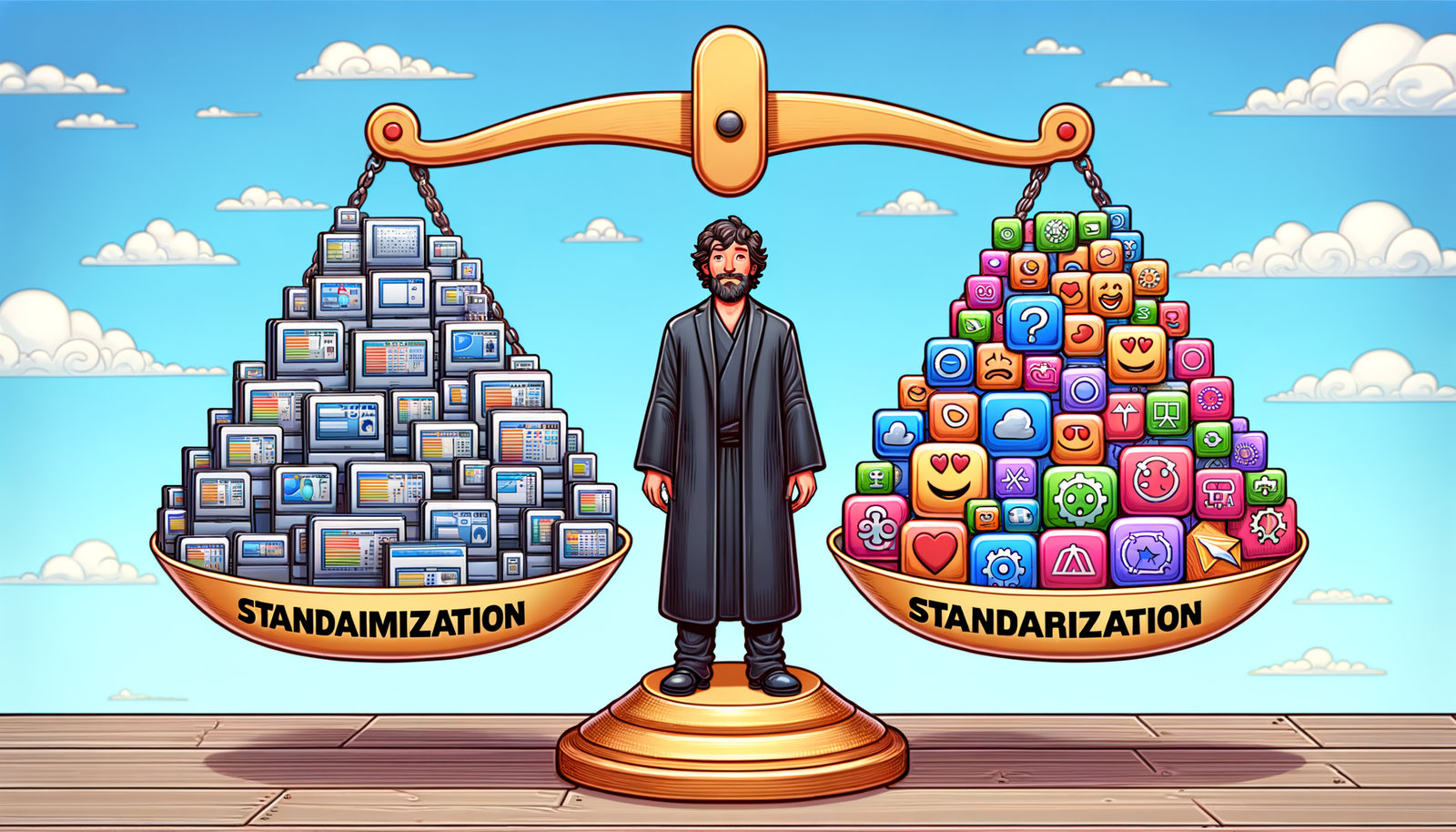Your Cart is Empty
Customer Testimonials
-
"Great customer service. The folks at Novedge were super helpful in navigating a somewhat complicated order including software upgrades and serial numbers in various stages of inactivity. They were friendly and helpful throughout the process.."
Ruben Ruckmark
"Quick & very helpful. We have been using Novedge for years and are very happy with their quick service when we need to make a purchase and excellent support resolving any issues."
Will Woodson
"Scott is the best. He reminds me about subscriptions dates, guides me in the correct direction for updates. He always responds promptly to me. He is literally the reason I continue to work with Novedge and will do so in the future."
Edward Mchugh
"Calvin Lok is “the man”. After my purchase of Sketchup 2021, he called me and provided step-by-step instructions to ease me through difficulties I was having with the setup of my new software."
Mike Borzage
Balancing Customization and Standardization in Design Software for Optimal Efficiency and Creativity
October 04, 2024 4 min read


Understanding Customization and Standardization in Design Software
In the realm of design software, customization refers to the ability of a tool to be tailored to meet specific user needs, preferences, or project requirements. This can involve adjusting settings, adding plugins, or even modifying the software's code to create unique functionalities. On the other hand, standardization denotes software solutions that adhere to established norms and offer a consistent set of features across all users and applications. These tools are designed to provide a uniform experience, promoting efficiency and ease of use.
Examples of customizable design software include platforms like Autodesk's Maya, which allows extensive scripting and plugin integration, enabling users to create bespoke tools within the application. Conversely, standardized design software such as Sketch offers a streamlined set of features focused on UI/UX design, ensuring a consistent experience for all users without the need for extensive modifications.
The evolution of design software has seen a significant shift from highly customized solutions towards more standardized offerings. In the early days of computer-aided design, software was often developed in-house or heavily modified to meet the unique needs of specific industries or companies. Key milestones in software development, such as the introduction of modular plugins and the rise of cloud-based applications, have prompted shifts towards standardization. These innovations have made it easier to distribute updates and maintain consistency across different user bases, emphasizing the importance of a unified approach in design tools.
The Benefits and Drawbacks of Customization
Customization in design software offers numerous advantages, foremost among them being the enhancement of user satisfaction through tailored features. By adjusting the software to fit specific workflows, designers can work more efficiently and effectively. This level of personalization allows tools to meet unique industry needs and project requirements that standardized software may not address. Additionally, customization fosters innovation by allowing users to experiment and develop new functionalities, pushing the boundaries of what the software can do.
However, there are significant challenges associated with customization. One of the primary drawbacks is the higher costs and longer development times required to implement and maintain custom features. This investment can be substantial, particularly for smaller organizations or individual users. There's also the risk of fragmentation, where different teams or departments use incompatible versions of software, leading to communication and compatibility issues. Maintenance challenges arise as customized software often requires frequent updates and ongoing support, adding to the overall resource burden.
-
Advantages of Customization:
- Tailored features enhance user satisfaction.
- Meets specific industry and project needs.
- Encourages innovation through experimentation.
-
Challenges of Customization:
- Higher costs and extended development times.
- Risk of fragmentation and compatibility issues.
- Requires frequent updates and ongoing support.
The Advantages and Limitations of Standardization
Standardization brings a host of benefits to the use of design software. It improves efficiency by providing streamlined processes and pre-established workflows that users can easily adopt. This uniformity enhances collaboration, as standardized tools are more likely to be compatible across diverse teams and integrate smoothly with other software. Consistency in outcomes is another significant advantage, making training and onboarding more straightforward since new users can rely on established procedures and documentation.
Despite these benefits, standardization also has its limitations. Standardized software is often less flexible in addressing unique project requirements, potentially limiting the scope of what designers can achieve. There's a risk that it may stifle creativity and innovation by confining users to predefined functionalities. Additionally, standardized tools may face obsolescence if they fail to adapt quickly to evolving design needs, leaving users with outdated capabilities that don't meet modern standards.
-
Benefits of Standardization:
- Streamlined processes improve efficiency.
- Enhanced collaboration across teams and tools.
- Consistency simplifies training and onboarding.
-
Disadvantages of Standardization:
- Less flexibility for unique project needs.
- May stifle creativity and innovation.
- Risk of obsolescence without adaptation.
Striking the Right Balance for Optimal Design Solutions
Finding the middle ground between customization and standardization is crucial for optimizing design solutions. One strategy is to adopt design software that offers a core standardized framework supplemented by customizable modules. This approach allows users to benefit from the stability and efficiency of standardized tools while still having the flexibility to adjust certain aspects to meet specific needs. Software like Adobe Photoshop exemplifies this balance, providing a robust set of standard features alongside the ability to add plugins and scripts for customization.
Another effective method is leveraging open-source software, which inherently supports customization but can be guided by community-driven standards to maintain a level of uniformity. Collaborations between software developers and user communities can lead to tools that are both versatile and consistent, fostering innovation without sacrificing compatibility or efficiency.
Looking ahead, emerging technologies such as artificial intelligence and machine learning are poised to facilitate better integration of customization and standardization. AI can enable software to learn from user behaviors and preferences, automatically adjusting features to suit individual workflows without the need for manual customization. Machine learning algorithms can establish patterns and standardize processes where beneficial while allowing deviations when unique requirements arise.
User feedback and community-driven development will play a pivotal role in shaping the next generation of design tools. As software companies increasingly engage with their user bases, they can create solutions that reflect the collective needs and insights of designers worldwide. This collaborative approach ensures that design software evolves in line with industry trends and user expectations, balancing flexibility and efficiency to deliver optimal design solutions.
Also in Design News

Cinema 4D Tip: Connect Objects + Delete for clean, export-ready meshes
December 26, 2025 2 min read
Read More
Revit Tip: Revit Conceptual Mass Workflow: Setup, Parametrics, and Conversion
December 26, 2025 2 min read
Read More
V-Ray Tip: Light Linking Best Practices for V-Ray for SketchUp
December 26, 2025 2 min read
Read MoreSubscribe
Sign up to get the latest on sales, new releases and more …


